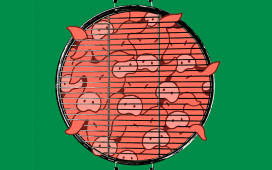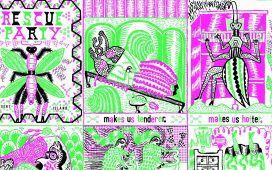Each summer, in London, I speak to a group of teens participating in Target Oxbridge, a program that encourages black students to apply to university. They ask me about my college experience and wonder what their own might be. One persistent anxiety trumps all: Will this make me less black? From here, the conversation expands into existential territory, as the students describe all the many behaviors and traits which they fear will place their blackness—in the eyes of others—in jeopardy. Things like reading or writing too much, wearing certain clothes, speaking a particular way, having been to private school, living in the countryside. Sometimes I ask them to imagine a group of white students sitting in our stead. What dangers could we conjure up that might put their whiteness in jeopardy? But we can only ever think of one item—extreme poverty—and even then it would likely not be their whiteness they’d consider endangered but only the privileges that may have once attended it. The imagined white students vanish. We sit together in our blackness and wonder: Can blackness really be so fragile that even a pair of narrow jeans may threaten it?
In Darryl Pinckney’s life and work, blackness is not so easily revoked. In his essays, a selection of which appear in a new volume, “Busted in New York and Other Essays,” blackness is as much in a black man’s possession at a British pro-fox-hunting demonstration as it is at the Million Man March—or while reporting on the protests in Ferguson. He will retain it while writing operas in Berlin, or falling in love (with a white male poet), or reading Nancy Mitford. His blackness remains his even as he ponders the historical fact (alongside James Baldwin and Ta-Nehisi Coates) that race is, in the final analysis, a social and political construction:
In his writings, Baldwin stressed that the Negro Problem, like whiteness, existed mostly in white minds, and in Between the World and Me (2015) Coates wants his son, to whom he addresses himself, to know this, that white people are a modern invention. “Race is the child of racism, not the father.”
As a piece of rhetoric, this has become increasingly easy to assert, and many say it, but it is Pinckney’s habit always to dig behind rhetoric to the historical record, where things are somewhat more difficult to say but no less true; for example, that blackness, too, must therefore be an equally modern invention, for white and black as categories are coeval, the creation of the first necessitating the other:
Colonial law quickly made a distinction between indentured servants and slaves and in so doing invented whiteness in America. It may have been possible for a free African or mixed-race person to own slaves, but it was not possible for a European to be taken into slavery. The distinction helped to keep blacks and poor whites from seeking common cause.
Pinckney’s emphasis on the interpolation of class and race can make him appear closer to the leftist Afro-Caribbean tradition of race theorists—exemplified by thinkers such as Paul Gilroy and Stuart Hall—who reject mythical or essentialist theories of racism in favor of a concrete economic analysis, in which racial distinctions have been created and maintained primarily for the sake of capitalist exploitation. For Pinckney, blackness is not an essential quality found in the blood, the spirit, or even the genes (“I’d never liked that way of assigning innate behavioral characteristics to whole nations or groups. The work of every serious social scientist militated against it.”) but a conceptual framework subject to history, like everything else. “The Irish used to be black socially, meaning at the bottom,” he writes in one example. “The gift of being white helped to subdue class antagonism.”
Of course, to say something is constructed is not to say that it isn’t meaningful. As Coates himself put it, with poetic succinctness, “They made us into a race. We made ourselves into a people.” And it is to the history of this people that Darryl Pinckney attends. The legislation to which we have been subject; the economic and social exclusion we have suffered; the experiences, both personal and public, that we have shared; our joys, our pains. But because he has a truly encyclopedic knowledge of black history—stretching far beyond America to every corner of the globe—the question of who and what this “we” contains remains at the forefront of Pinckney’s inquiry. What exactly do “we” share? How do “we” diverge? From the concluding lines of his essay on Coates, “The Afro-Pessimist Temptation”: “Black life is about the group. . . . This remains a fundamental paradox in the organization of everyday life for a black person.” Reading these lines, I thought of those students in London, never quite sure as to how or where they should draw the Venn diagram between the selves they feel so strongly and the “we” to which they no less profoundly belong. Can a diaspora be a monolith? Should it be?
In “Slouching Toward Washington,” Pinckney’s account of attending the 1995 Million Man March, this question is no thought experiment but a pressing problem: “Everyone seemed in a prescriptive frame of mind, willing to go on record about what black men and therefore black people needed to do.”
As anyone who has been to a march knows, you find yourself on such occasions shoulder to shoulder with ideological brothers, cousins, and strangers, and, as moved as Pinckney is by the huge crowd, by the solemn courtesy each man shows the other as they move through the throng—“Excuse me, brother . . . excuse me, black man”—not every speech he heard that day spoke to him, and not every voice lifted was the song he wanted to sing. He hears “a troubling capitulation in the exhortations that black men accept responsibility for their families” (he hears the same capitulation thirteen years later, when Obama makes a similar cri de coeur) and wonders why all the men on the Mall that day should have to “swear as black men not to beat their wives, promise as black men not to abuse their children . . . as if domestic violence and poverty were not also white problems.” Pinckney is the inconvenient scholar who knows, when Louis Farrakhan stands up and purports to quote a letter of 1612, written by one Willie Lynch, slave master, that this letter is a fraud, written in language that in no way belongs to the early seventeenth century—and yet there is nothing vituperative in his style, and he’s never out for anybody’s blood. “No doubt [Farrakhan] assumed that everyone understood the letter was apocryphal, a parable about fear, envy, and distrust, the means by which blacks are kept disunited,” he writes.
Still, the truth matters. “An invented past can never be used,” Baldwin argued, and Pinckney’s historical precision reminds us that there is more than sufficient systemic oppression in the black past and the black present not to require any added fictionalization. “Instead of Farrakhan’s murky ‘conspiracy of whites against blacks,’ ” he writes, we might consider that, in the first quarter of the nineteenth century, Alabama, Georgia, Louisiana, North and South Carolina, and Virginia passed anti-literacy laws, some of which included prison time for anyone who taught a slave to read and write (a fact perhaps worth offering to any young person who fears excessive reading is somehow “not black”), while, as Farrakhan speechified, there existed a perfectly nonfictional, racially biased criminal-justice system that destroyed the lives of far more than a million black men.
When, in the book’s title essay, Pinckney finds himself briefly incarcerated (for smoking a joint in the East Village), he recognizes at once his own distance, despite appearances, from his fellow-inmates (all of whom are black or Hispanic), a difference marked not by color but by class. (“The irony, for me, was that an all-black gathering usually meant a special event, a stirring occasion.”) Raised in Indianapolis, in the black bourgeoisie of the early sixties—the world of N.A.A.C.P. meetings and black-owned newspapers, of prestigious black colleges and “Negro History Week”—he is attentive to the hierarchies of black struggle, even as the struggle itself renders his own experience invisible:
Back then, as now, what constituted authentic blackness was determined by the plight of the majority, which meant the poorest . . . being of the black middle class could make you defensive. You were accused of trying to act white, of not knowing who you were. You were warned that one day soon it would be proven to you that you were black. . . . In the late 1960s, the black bourgeoisie was synonymous with Uncle Tom . . . depicted as light-skinned, clubbish, collaborationist, materialistic; and yes, there was too much of that.
For Pinckney, this image has also “obscured the historical truth” of his milieu. “The old black middle class knew more than it wanted to about the front line,” he writes. “There was no refuge in success. A cousin of my mother’s, a student at Atlanta University, was lynched in 1931.”
It is this awareness of threat, the deadly patrimony of the African-American, that he takes with him as a journalist to Ferguson, listening to the testimony of the people he finds there, bearing witness. Embedded with members of Black Lives Matter and the Reverend Osagyefo Sekou, an activist pastor from St. Louis, Pinckney finds himself far from his usual habitat—the Schomburg library—hiding in the dark of a parking lot, listening to the sound of gunfire as “buildings burned on either side of us.” In Ferguson, too, he experiences a new generation’s disappointment with the same President the old men in Pinckney’s barbershop had heralded with the joy of a prize long deferred. “Black youth are fed up with being branded criminals at birth,” he writes. “Ferguson was the country stepping back in time, or exposing the fact that change hasn’t happened where most needed, that most of us don’t live in the age of Obama.” Pinckney does not share Sekou’s contempt for that President (“I wanted to say that Clarence Thomas is the race traitor, not Obama”), but he understands that whatever future Obama symbolized was—to paraphrase William Gibson—at the very least unevenly distributed.
Such a schizophrenic reality, in which black power, in the form of a President, and black powerlessness, in the form of state violence and oppression, can coexist would surely bring out the Afro-pessimist in any reasonable man. (“Given the little black people have gotten for it,” the Reverend Sekou tells Pinckney, in Ferguson, “voting fits the popular definition of insanity: doing the same thing over and over and each time expecting a different result.”) Yet to entirely elide the difference between the present and the past is to obscure the history of black activism found in families like Pinckney’s, in families like Coates’s, in the N.A.A.C.P. and the Black Panthers and Black Lives Matter, and in all the other organizations and individuals that have done so much to insure that the lives we are able to live today, however imperfect, are precisely not the same as they ever were. “Which is better,” Pinckney asks himself, to “believe that blacks will achieve full equality in American society or to realize that white racism is so deep that meaningful integration can never happen, so make other plans?” It is a question he does not answer as much as historicize:
In The Souls of Black Folk (1903), Du Bois argued that the influence of three main attitudes could be traced throughout the history of black Americans in response to their condition: “a feeling of revolt and revenge; an attempt to adjust all thought and action to the will of the greater group; or, finally, a determined effort at self-realization and self-development despite environing opinion.
And this insistence on historicization allows him to take the long view on many present pains that may otherwise seem confounding to young people experiencing them for the first time. Instead of adjudicating a painful public spat between Coates and Cornel West, for example, Pinckney places it within a tradition, a long and glorious history of contention within black letters, in which “everyone accus[es] everyone else of running a con”:
In later years, [Ralph] Ellison remembered [Richard] Wright as a father figure whom he had quickly outgrown. But Wright’s example inspired the young James Baldwin to move to Paris in 1948. Wright was hurt when Baldwin declared his independence from the protest tradition by denouncing Native Son. Baldwin later defended his criticism, arguing in part that Wright’s concentration on defining his main character by the force of his circumstances sacrificed that character’s humanity. Baldwin’s turn would come.
Indeed, as Pinckney points out, LeRoi Jones, in his essay collection “Home,” from 1966, “sneered at Baldwin” for being popular on the “white liberal cocktail circuit.” That LeRoi Jones, even after he became Amiri Baraka, remained popular on the white-liberal cocktail circuit, that Baldwin also sometimes sacrificed a character’s humanity for a force of circumstance—into these weeds Pinckney does not go, recognizing instead that this Oedipal battle between fathers and forefathers is practically a black intellectual’s rite of passage. He is not interested in separating good black from bad, nor in discovering who is the “realest.” His focus is black history itself, its twists, its turns, its triumphs and self-negations.
For Pinckney, separatism in particular is an old song come round again, although this time appearing mainly as “a rhetorical strategy of the tradition,” divorced from the kind of black-focussed organization and political interventions represented by the Panthers or, much earlier, in the founding of the historically black colleges and incorporated black towns. In the new language of Twitter militancy, “we just can’t” with white people anymore . . . and yet here we are and here they are, so what is to be done? As he points out, a despair cannot be total if someone has taken the time to write it out, for even to “address an audience beyond black people is to be still attempting to communicate and enlighten.” One recurring pattern in militancy is that one man’s militant is another’s Uncle Tom:
The reinvigoration of the marketplace of discussion about that invention, race, has always depended on the passing of the torch, on another generation coming along as a corrective to the one before it, the assumption being that the next generation will be more real and finally tell it like it is.
If Pinckney is suspicious of this black authenticity contest, it may be because he exists at the intersection of several identities—black, gay, bougie—and so is familiar with how quickly a “we” can become a “you” and an “us.” One of the most striking moments in this book occurs when, while reporting on Hurricane Katrina, Pinckney finds himself in a black New Orleans that seems to welcome him with open arms, which he confesses comes as a surprise to a man who, out of habit and long experience, is used to “bracing myself for the anti-Tom vibe or the anti-queer vibe.” He is, that day, not “you” but “we,” fully included in a black space at a time of black tragedy. Katrina seemed to confirm that what Coates has called “King’s gauzy all-inclusive dream” of multiracial solidarity had been, as Pinckney puts it, “replaced by the reality of an America of competing groups, with blacks tired of being the weakest of the lot.”
Still, within this “weakest” group, Pinckney wants us to remember that there is difference and divergence—and plenty of it. Writing about the saga of Henry Louis Gates, Jr., the Harvard professor who, in 2009, was arrested on his porch by a Cambridge officer, Pinckney casts an unusually caustic eye over “The Presumption of Guilt: The Arrest of Henry Louis Gates, Jr. and Race, Class and Crime in America,” a book by the Harvard Law professor Charles Ogletree, in which Ogletree interviews upper-middle-class black men, many of them Harvard-educated, as they offer similar encounters of mistaken identity. Given that everyone approached for the book is of the privileged class, Pinckney wonders, is the unspoken assumption that the real offense is wounded class pride?
One quickly understands the irritation of the black working poor with the outrage of black professionals at the social indignities they encounter. There are worse things than not having one’s high social status acknowledged by whites. Maybe the point is that no black person should have to stomach any bigotry, but the resentment Ogletree’s men . . . express at having been taken for a servant or menial by whites could make one wonder if their parents ever told them that they themselves ought not to judge a black man by the work he was able to find.
We are prompted to ask ourselves why Gates’s tale of high-status humiliation was so much more compelling, at that moment, in America, than the undisguised systemic racism that continued, throughout the Obama years, to support a prison system in which working-class black men were grossly overrepresented.
In his insistence on such awkward questions, Pinckney proves himself, as one essay title confesses, “Under the Spell of James Baldwin.” For Baldwin never tired of being awkward. Pinckney’s Baldwin, though, is not quite the Baldwin currently experiencing a surge of popularity: the late Baldwin, the TV-talking-head Baldwin, the celebrity Baldwin selectively quoted in the film “I Am Not Your Negro.” Indeed, what Pinckney’s several essays on Baldwin reveal is that Baldwin can only be selectively quoted—he espoused so many different, often contradictory, ideas over the years that whichever Baldwin we want is generally the one we tend to get. Pinckney’s Baldwin not only did not despair of the possibility of racial coexistence but considered it existentially vital. (“We, the black and the white, deeply need each other if we are really to become a nation—if we are really, that is, to achieve our identity, our maturity, as men and women. To create a nation has proved to be a hideously difficult task: there is certainly no need now to create two, one black, and one white.”) Pinckney’s Baldwin not only implied that white people can be fellow-travellers in the struggle but that it was possible for his own favorite teacher, a white woman, to be structurally yet not actually black:
She gave me books to read and talked to me about the books, and about the world: about Spain, for example, and Ethiopia, and Italy, and the German Third Reich; and took me to see plays and films, plays and films to which no one else could have dreamed of taking a ten year old boy. . . . It is certainly partly because of her . . . that I never really managed to hate white people—though, God knows, I have often wished to murder more than one or two. . . . From Miss Miller, therefore I began to suspect that white people did not act as they did because they were white but for some other reason, and I began to try to locate and understand the reason. She, too, anyway, was treated like a nigger, especially by the cops, and she had no love for landlords.
And of course Baldwin is also the black writer who was so good at appropriation (or assimilation? Or fiction?) that his most famous novel is narrated in the first person by a white man. In place of the consistent black saint we have recently been offered, then, Pinckney gives us back the fabulously inconsistent man and writer, shot through with both self-hatred and self-love, filled with rhetorical fireworks and hot air and pure genius. The Baldwin who, like Pinckney himself, escaped the American struggle for a while—or got a new perspective upon it—by leaving for Europe.
Many go to Paris; Pinckney went to Germany and England. Like for Baldwin, Wright, and Ellison before him, leaving the U.S. brought both exhilaration and anxiety. “You could still find a sort of prejudice among black people against European expatriatism,” he writes, “as if it were only a rung below passing for white”—again, merely an individual solution to what was a problem for the black masses. But his spell abroad in no way lessened his fascination with the diaspora. Instead, in his European essays, he tracks black lives on unexpected journeys and down strange back alleys.
It is a delight to follow him. How would I ever have heard of a book like “A Black Woman’s Odyssey Through Russia and Jamaica: The Narrative of Nancy Prince” if not for Pinckney’s digging it up? I never knew the Communist Party worked to support the Scottsboro Boys, nor that “the cause of freedom for black people mattered to the leading writers of the Romantic movement: Wordsworth, Coleridge, Southey, Byron, Shelley,” nor even that “Greenwich Village was a black neighbourhood when Dickens visited in 1832.” In his beloved Berlin, while walking through the German Historical Museum, Pinckney finds that “the chapter on German colonialism occupied a single glass case under some stairs,” where the fact that the German Army massacred thousands of the Herero and Nama people in the early twentieth century is acknowledged only in a brief piece of text on the wall. In London, he wonders at British racial myopia (“Britain seemed to tell itself that black people only got to its shores in 1948 with the HMT Empire Windrush. . . . It was as though British people had never asked themselves what happened to the Africans who lived in London or Bristol in the 18th Century”) but also discovers, in the busy migrant streets, a useful corrective to lazy American ideas of Pan-Africanism: “Nigerians were not Ghanaians, Kenyans were not South Africans, just as someone from Jamaica was not someone from Trinidad.” (This simple but important point reminds me of a conversation I had about “Black Panther” with a Ghanaian friend while we sat at a table full of Americans. Asked what she thought of it, my friend smiled and said, “Imagine a film featuring a fictional European country in which some people dress like Kenyans, some like Ghanaians, some like Nigerians, some like Ethiopians, and so on, and then everybody has the same ‘European’ accent, somewhere between Spanish, French, German, and Polish. . . .”)
For Pinckney, returning to the States means reëntering the world of his parents, and taking up once more his duties as they saw them, though with a new awareness of his own complicated role:
Achievement was self-sacrifice. You must not forget where you came from. You stood on the shoulders of the past. You were one of many. This was serious. You were one of the fortunate and therefore you had a historic destiny to help other black people. My black life was straight; in my white life I could be queer. . . . The connection in my mind between expatriatism and sexual freedom was very strong. It had a lot of fantasy and self-justification in it. . . . To talk about things black at home . . . was a way of not talking about myself while seeming to. I used my being black as a way to hide from my black family.
Few are willing to acknowledge that sometimes the things we declaim most strongly usefully disguise the things we find hardest to admit, even to ourselves. “What’s new in racism” happens also to be the first subject of conversation each time I am reunited with my own family, and reading the quote above made me wonder: How much intimate and personal information is sidelined and obscured as we discuss what the President said about Africa, or how the Italians are treating their migrants? “The very serious function of racism . . . is distraction,” Toni Morrison once said. Can it even distract us from the “I” that we are?
Leaving home has its advantages, but also its costs. Considering the case of the Jamaican writer and poet Claude McKay, Pinckney writes, “His example haunts me. He paid for having been away so long. One day he woke up and discovered that he was out of it and unwanted.” Pinckney, too, was away a long time, while West and Gates, Jr., established each their own fiefdoms, and while Morrison accepted her Nobel, and now he finds himself back in Harlem, right in the middle of what feels to many—to me!—like a second Renaissance. For Pinckney, it must feel something like the fifth or sixth: “The culture of the black diaspora has arrived. Again.” And with it comes a dizzying array of arguments, poses, stances, and claims, some of them surely bewildering to a man who has already lived through so many twists and turns in black history. “I can’t keep up,” he tells us, “and often I can’t sign on.” No matter. “Hotep” may not be in his vocabulary, but, with his portrait of Farrakhan, he offers an indelible example of one. Besides, we have enough people keeping up with the latest debates and signing on with the hottest hashtags. Those interested in the culture of the black diaspora come to Pinckney’s work for other reasons. To know our multifaceted history. To figure out what progress we’ve made and how far there is to go, though Lord knows consensus on this matter is unlikely. Recently, I noticed that even the lyrics of “Lift Ev’ry Voice and Sing”—the so-called black national anthem—are open to interpretation:
We have come, treading our path thru the blood of the slaughtered,
Out from the gloomy past, till now we stand at last
Where the white gleam of our bright star is cast.
God of our weary years, God of our silent tears,
Thou who hast brought us thus far on the way;
Thou who hast by thy might led us into the light,
Keep us forever in the path, we pray.
How far is “thus far”? Have we ever been in the light? And, come to think of it, are the “light” and the “white gleam” in those lyrics actual liberations or symbols of a colonized consciousness? Over such disputed territory does black intellectual life rove. No one knows how far we are down the path—we haven’t even agreed on the destination. (Kathleen Collins: “I believe in liberation, but I don’t believe it is at all the thing we think it is.”) But that’s O.K. We’re lifting every voice and singing, often quite different tunes. And how lucky we are to have Darryl Pinckney, who, without rancor, without insult, has, all these years, been taking down our various songs, examining them with love and care, and bringing them back from the past, like a Sankofa bird, for our present examination. These days, Sankofas like Pinckney are rare. Treasure him!
This essay was drawn from the introduction of “Busted in New York and Other Essays,” which was published in November by Farrar, Straus and Giroux.








